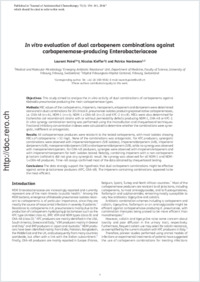In vitro evaluation of dual carbapenem combinations against carbapenemase-producing Enterobacteriaceae
- Poirel, Laurent Medical and Molecular Microbiology ‘Emerging Antibiotic Resistance’ Unit, Department of Medicine, University of Fribourg, Switzerland
- Kieffer, Nicolas Medical and Molecular Microbiology ‘Emerging Antibiotic Resistance’ Unit, Department of Medicine, University of Fribourg, Switzerland
- Nordmann, Patrice Medical and Molecular Microbiology ‘Emerging Antibiotic Resistance’ Unit, Department of Medicine, University of Fribourg, Switzerland - HFR-Hôpital Cantonal, Fribourg, Switzerland
-
23.08.2015
Published in:
- Journal of Antimicrobial Chemotherapy. - 2016, vol. 71, no. 1, p. 156–161
English
Objectives: This study aimed to analyse the in vitro activity of dual combinations of carbapenems against Klebsiella pneumoniae producing the main carbapenemase types.Methods: MIC values of the carbapenems, imipenem, meropenem, ertapenem and doripenem were determined alone and in dual combinations for 20 clinical K. pneumoniae isolates producing representative carbapenemases, i.e. OXA-48 (n = 6), NDM-1 (n = 4), NDM-1 + OXA-48 (n = 2) and KPC-2 (n = 8). MICs were also determined for Escherichia coli recombinant strains with or without permeability defects producing NDM-1, OXA-48 or KPC-2. In vitro synergy combination testing was performed using the microdilution and chequerboard techniques. Fractional inhibitory concentration indexes were calculated to determine whether the combinations were synergistic, indifferent or antagonistic.Results: All carbapenemase producers were resistant to the tested carbapenems, with most isolates showing MICs of carbapenems >32 mg/L. None of the combinations was antagonistic. For KPC producers, synergistic combinations were observed with imipenem/ertapenem (5/8 isolates), imipenem/doripenem (4/8), imipenem/doripenem (4/8), meropenem/doripenem (3/8) and ertapenem/doripenem (3/8), while no synergy was observed with meropenem/ertapenem. For OXA-48 producers, synergies were observed with imipenem/ertapenem and with imipenem/meropenem for both isolates tested. Notably, combining imipenem with a non-carbapenem β-lactam (cefalotin) did not give any synergistic result. No synergy was observed for all NDM-1 and NDM-1+OXA-48 producers. Time–kill assays confirmed most of the data obtained by chequerboard testing.Conclusions: The data strongly support the hypothesis that dual carbapenem combinations might be effective against serine-β-lactamase producers (KPC, OXA-48). The imipenem-containing combinations appeared to be the most efficient.
- Faculty
- Faculté des sciences et de médecine
- Department
- Médecine 3ème année
- Language
-
- English
- Classification
- Biological sciences
- License
- License undefined
- Identifiers
-
- RERO DOC 258014
- DOI 10.1093/jac/dkv294
- Persistent URL
- https://folia.unifr.ch/unifr/documents/304726
Statistics
Document views: 49
File downloads:
- nor_ved.pdf: 105
